
Credit: Great Sand Dunes National Park and Preserve, via Wikimedia Commons
Did you know that sand dunes...can sing?
Sand dunes form wherever there’s sand and steady wind to blow it into piles. Deserts cover 20 percent of Earth’s land surface and many have dunes. There are even sand dunes on other planets.
Here on Earth, sand dunes sing in about three dozen known locations. This has baffled explorers since Marco Polo crossed China’s Gobi Desert in the thirteenth century and attributed the loud noises to spirits.
And scientists still don’t understand it completely. But it has to do with the sand itself.
In singing dunes, the sand crystals are well rounded and covered in a silica-water gel coating called desert glaze.
When the sand is hot and very dry, and tumbles down the dune face, the crystals vibrate against one another. This produces tiny sound waves that synchronize with and amplify each other, growing into moans, whines or whistles that can be louder than a lawn mower.
If the sand grains are a uniform size, the dune will produce a pure tone. If the grains are of different sizes, they’ll produce several notes to form a chord. Listen...
(Fade out music and fade in about eight seconds of singing sand recording. Fade out.)
In the U.S., White Sands National Monument has been singing for thousands of years, as documented by native peoples. When you visit, maybe they’ll sing for you.
Background
Synopsis: Sand dunes form by aeolian processes anywhere there is a supply of dry sand and a consistent wind source. They range from inches to thousands of feet high and can be found on every continent on Earth, as well as on other planets. Under certain conditions, some dunes are musical, burping or humming a booming ethereal tone or chord as their sand grains move. These are Earth’s rare singing dunes, first documented by Marco Polo, which only occur in about three dozen locations. How do they make their music?
- Dunes form when the wind blows sand or dust into a pile, known as an aeolian process.
- Deserts cover about 20% of Earth’s land surface, but only 10% of deserts are covered by dunes.
- Dunes also form along beaches and riverbanks, providing habitat and protecting coastal areas from erosion and storm surges.
- To form a dune, there must be an ample source of sand or dust that is dry enough to be mobilized by consistent strong winds. Dunes accumulate as wind velocity slows or when an obstacle causes the wind to drop its sediment load.
- Winds transport sand up the windward face of a dune to the crest, where it drops downward along the leeward slipface, typically at the steepest angle possible for a granular medium, the angle of repose. This angle is 30–35° for dry sand.
- Dunes are classified into five styles that form depending on sand supply versus wind directions and velocity: barchan, parabolic, transverse, longitudinal and star.
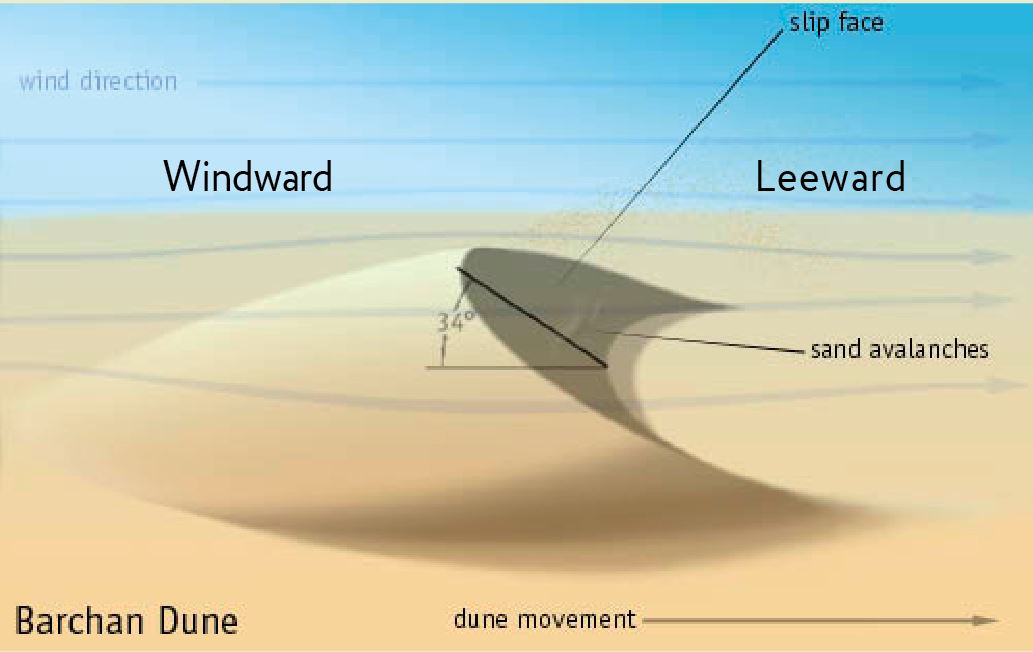
Barchan dunes are conceptually simple dunes that form where sediment supply is limited and the wind blows consistently from one direction.
Credit: Merikanto, via Wikimedia Commons - In areas of plentiful sand and wind, dunes merge into dune fields and ergs (sand seas) that can range up to thousands of square miles in extent. Several ergs occur in different parts of the Sahara Desert.
- The height of dunes varies as the wind sculpts them, but they range from 2.75 in (7 cm by definition) to 4,035 ft (0.8 mi or 1,230 m) tall, four times the height of Paris’s Eiffel Tower.
- Earth’s tallest dunes are all more than 1,640ft (500m) tall and can be found in Argentina, Peru, Chile and China. Bedrock geology and high core water content are thought to enable these dunes to maintain their extreme heights.
- In the Sahara Desert, dunes average 1,410ft (430 m), just a few meters shorter than the Empire State Building (including its spire and antenna).
- Sweeping dunes are visually inspirational, but, in rare cases, dunes can also be musical.
- Explorers from Marco Polo in the thirteenth century to Charles Darwin in the nineteenth century documented their astonished experiences with “singing,” “whistling,” or “booming” sands.
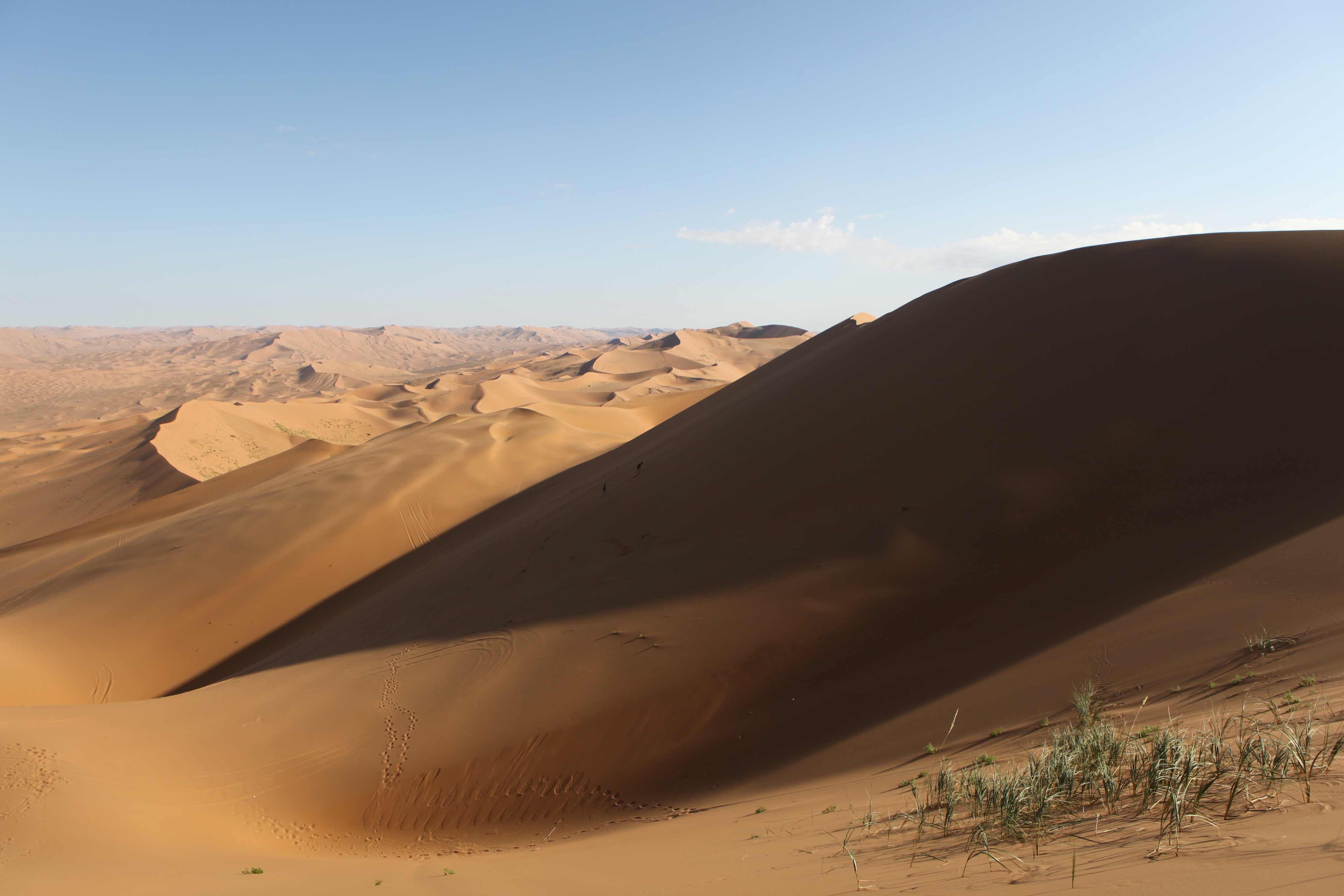
In the thirteenth century, young Marco Polo traversed China’s Badain Jaran megadunes (shown in the image) in the western Gobi Desert on his way to the court of Kublai Kahn, describing extraordinary sounds of the desert as filling the air “with the sounds of all kinds of musical instruments, and also of drums and the clash of arms; obliging the travelers to close their line of march and to proceed in more compact order.” He attributed these eerie sounds to spirits.
Credit: Sjoerd van Oort, via Wikimedia Commons
- Explorers from Marco Polo in the thirteenth century to Charles Darwin in the nineteenth century documented their astonished experiences with “singing,” “whistling,” or “booming” sands.
- There are only about three dozen places on Earth where sand dunes sing, emitting loud, deep tones that last for minutes and can be heard from miles away.
- Some dunes blast out sounds at more than 105 decibels, louder than a lawn mower, motorcycle, car horn or rock concert.
- These booming noises can be heard as far as 6 mi (10 km) away and last as long as 15 minutes.
- Different dunes hum different tunes in the lower part of a cello’s frequency range.
- At Nevada’s Sand Mountain, the dunes hum tones between low B to C sharp (60–70 Hz), two octaves below a piano’s middle C.
- Slightly higher in the same octave, Chile’s Mar de Dunas sings a low F (87 Hz).
- Singing dunes also produce shorter burping noises when disturbed by footsteps or pushing sand.
- Although it is still not completely understood, many researchers have studied this phenomenon, noting several factors singing dunes have in common.
- It is the sand that sings, not the dune. Singing sand produces sounds even if it is removed from the dune to a laboratory. Sand from dunes that don’t sing in nature can’t be made to sing in the lab.
- Singing dunes are usually composed of well-rounded very fine to medium silica sand grains (100–500 microns) with surfaces roughened by pitting from aeolian transport.
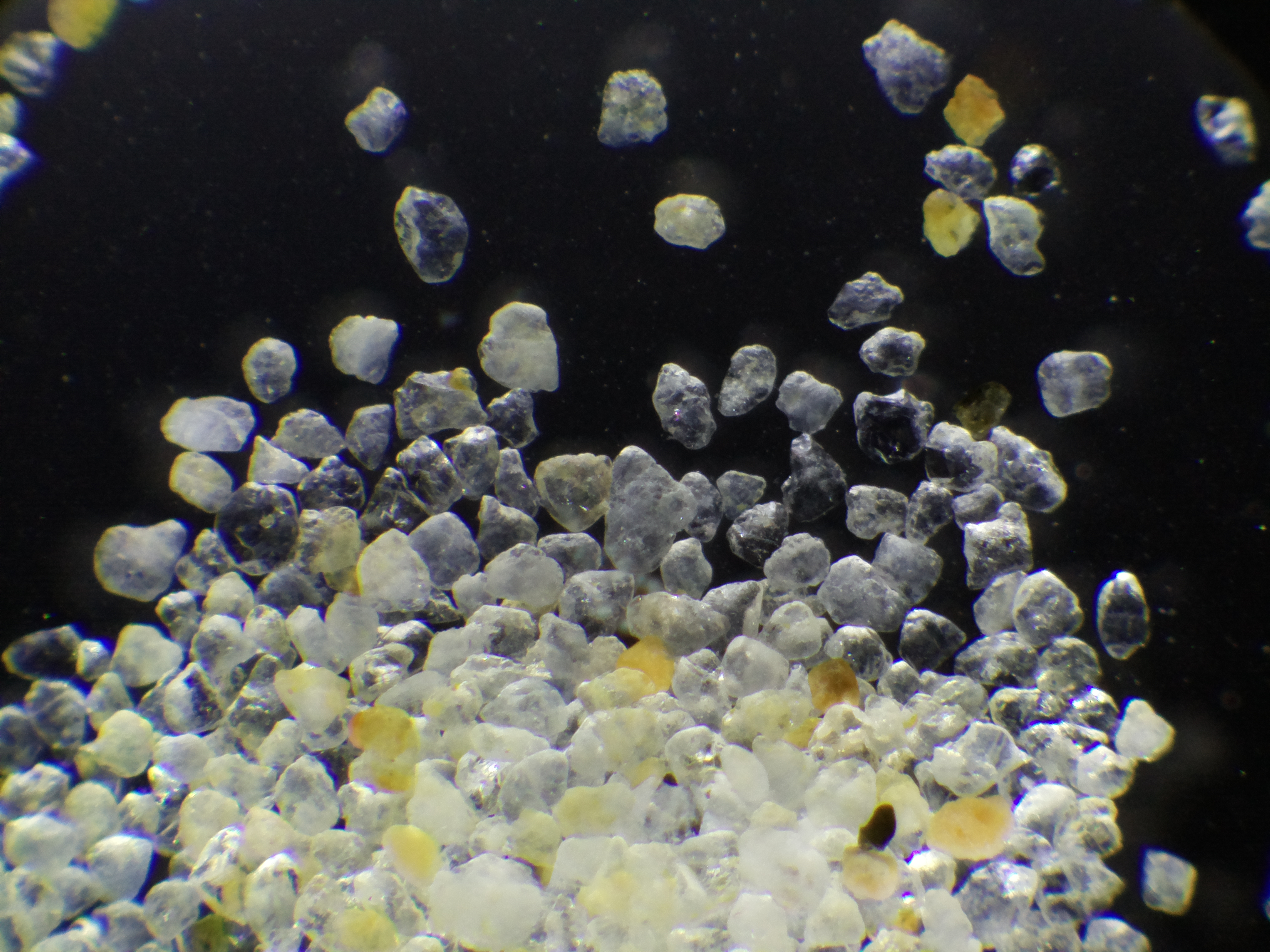
Grains of singing sand under a microscope, from Paradise Beach, Gold Coast, Australia.
Credit: PeterKopias, via Wikimedia Commons - Studies of various singing sands show a silica-water gel coating known as desert glaze is precipitated during repeated wetting and drying of the grains, further increasing the surface stickiness of the grains. This is thought to be important because singing sands transported to the lab eventually lose their ability to emit sound after intensive use, possibly as the desert glaze wears down.
- Dunes only sing when sand is in motion, producing their sustained tones during avalanches. Singing dunes tend to be large with steep leeward slipfaces (>30°) that sustain larger avalanches. Some dunes sing as frequently as several times an afternoon.
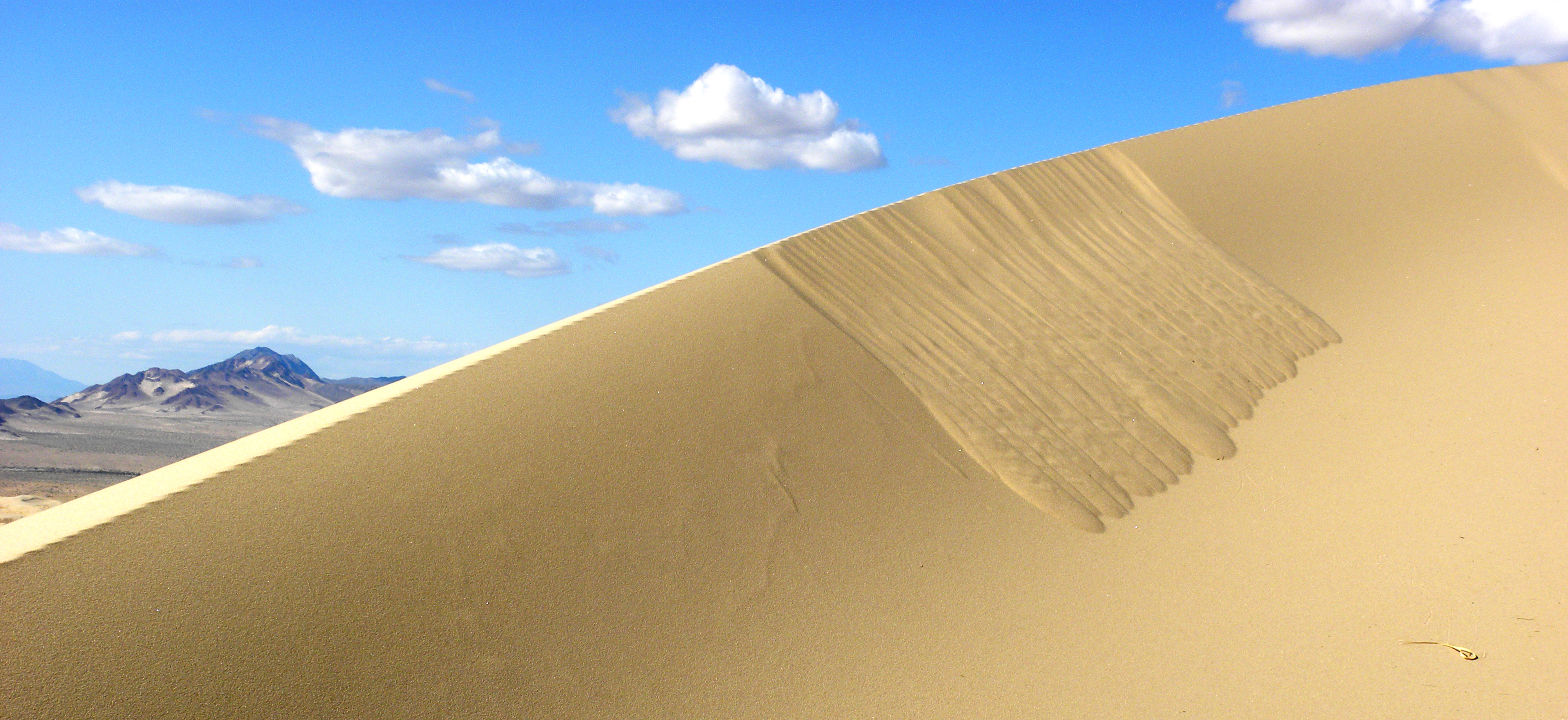
Avalanche deposits on a crest of the singing Kelso Dunes, the largest field of aeolian sand deposits in the Mojave Desert, located within the Mojave National Preserve in Southern California.
Credit: Mark A. Wilson (Department of Geology, The College of Wooster), public domain, via Wikimedia Commons - The sand must be hot and extremely dry to sing. Dunes won’t sing in winter when increased internal moisture causes grains to adhere to each other.
- The frequency of a dune’s song can be correlated to the size of sand grains in the dune. Finer grain sizes are associated with higher pitch. Well sorted sands produce pure tones compared to blended chords produced by sands with a wider range of grain sizes. Mystery of Singing Sand Dunes | Omani Chord and Moroccan Tone 1:25 Video
- The Ghord Lahmar in Morocco with sand size of 150 to 170 microns moans a low G sharp (105 Hz).
- Dunes near Al Ashkharah, a coastal town in southeastern Oman with grain sizes ranging from 150 to 310 microns, harmonize using nine notes ranging from low F sharp to bass D (90–150 Hz). If sand from this dune is sieved and the experiment is repeated with only the 200 to 250 micron component, a single pure tone results.
- While there are many conclusions, scientists agree that the sounds are produced when millions of grains flow over each other, producing vibrations that self-synchronize. The Song of the Dunes with Stéphane Douady | Morocco 4:05 Video
- During granular shear flow in an avalanche, each grain creates a local sound wave as it tumbles through the fluidized sand layer, colliding with other grains about 100 times per second.
- Some studies suggest that after bouncing off the free upper surface of the layer, the waves self-synchronize to produce a coherent resonance that amplifies and sustains the sound.
- The frequency of the sound is produced by shear forces related to the relative motion of the sand grains and is dictated by their grain size. The frequency is the same at different locations on a dune and on nearby dunes of varying size as long as the sand characteristics are the same.
- Recent studies have shown that the burping sounds associated with quick motions like footsteps or hand swipes produce surface Rayleigh waves that quickly disperse, distinguishing them from the booming slipface avalanches. The avalanches begin with burps as the sand starts to move but then transition to more powerful nondispersive P-waves that vibrate through the whole dune.
- More singing dunes can be found in several locations in North America and globally.
- Singing dunes cover an area of about 77 square kilometers and reach a height of over 741 ft (225 m) at Great Sand Dunes National Park and Preserve, tucked into the western Sangre de Cristo Mountains of southern Colorado. These dunes have been singing for nearly 12,000 years and produce a variety of sounds, ranging from a low groan to a high-pitched whine. Singing Sands of Great Sands Dunes National Park | Colorado 0:19 Video
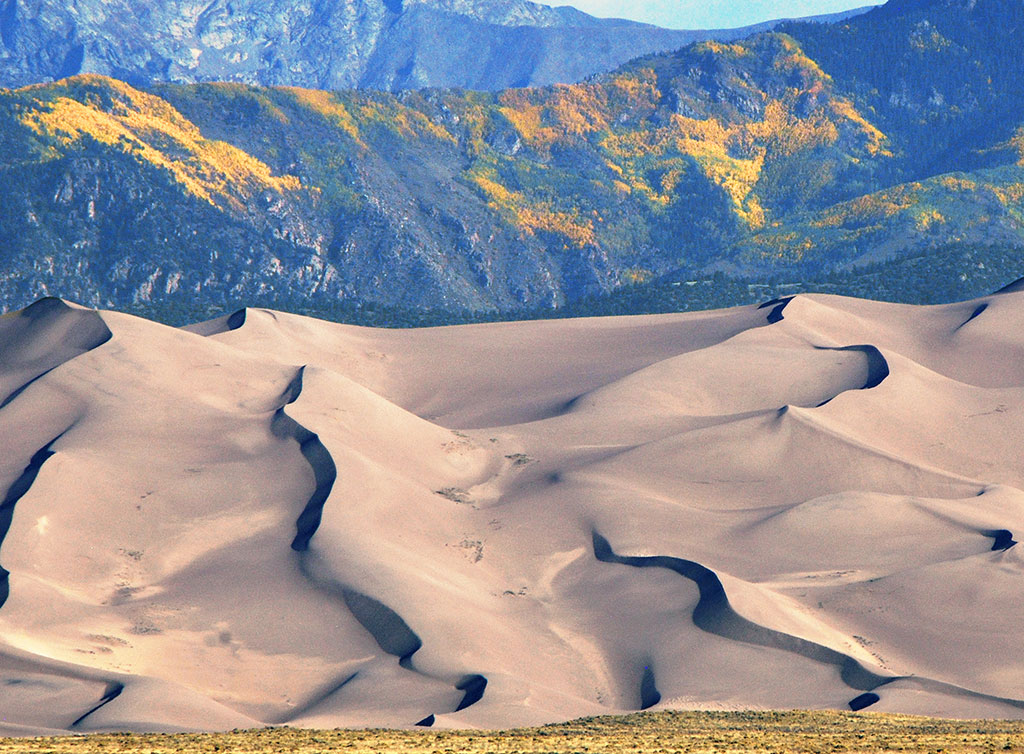
The beautiful curving dunes of Great Sand Dunes National Park accumulated in a bend in the Sangre de Cristo Mountains of Colorado, shown here with gold-leaved aspen trees in the fall. The tallest dune in the United States is Star Dune at Great Sand Dunes National Park and Preserve at about 720 feet (230 meters).
Credit: NPS Natural Resources, public domain, via Wikimedia Commons - Kelso Dunes, also known as the Mojave Dunes, are located in the Mojave National Preserve in Southern California, covering an area of about 45 square kilometers with heights of over 650 ft (200 m). The dunes produce a low, booming sound that can be heard from miles away.
- Other locations where singing dunes can be found in North America include Utah’s Coral Pink Sand Dunes State Park, the White Sands National Park in New Mexico, Idaho’s Bruneau Dunes State Park, Nevada’s Sand Mountain, and the Warren Dunes in Michigan.
- The Badain Jaran megadunes that Marco Polo experienced in the western Gobi Desert reach more than 1,600 ft (490 m) tall and are some of the loudest dunes on Earth.
- Other international singing dune sites are located in Mongolia, Kazakhstan, Japan, Namibia, Egypt, Wales and others.
- Singing dunes cover an area of about 77 square kilometers and reach a height of over 741 ft (225 m) at Great Sand Dunes National Park and Preserve, tucked into the western Sangre de Cristo Mountains of southern Colorado. These dunes have been singing for nearly 12,000 years and produce a variety of sounds, ranging from a low groan to a high-pitched whine. Singing Sands of Great Sands Dunes National Park | Colorado 0:19 Video

